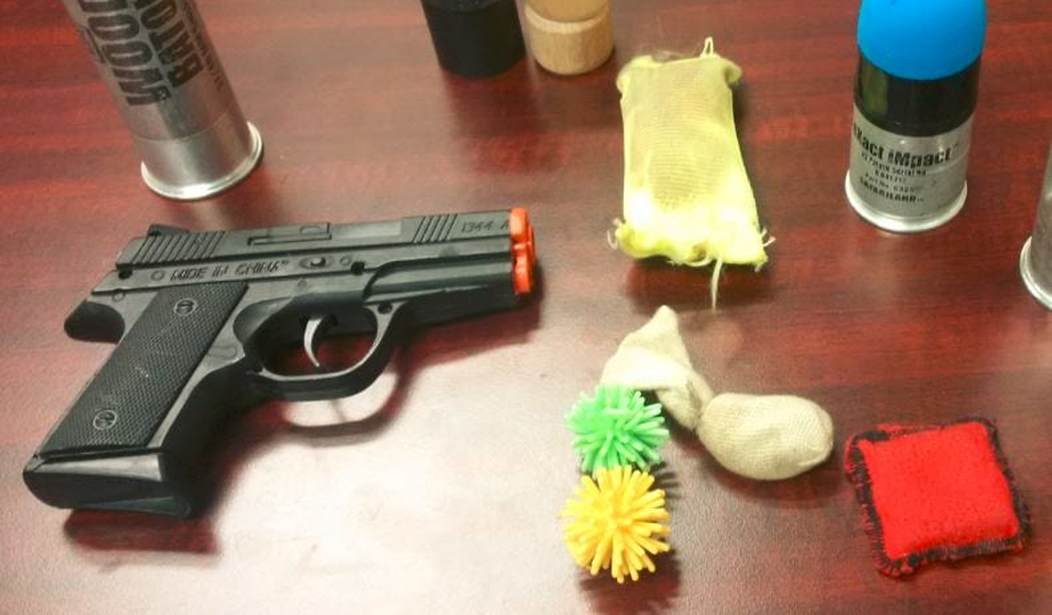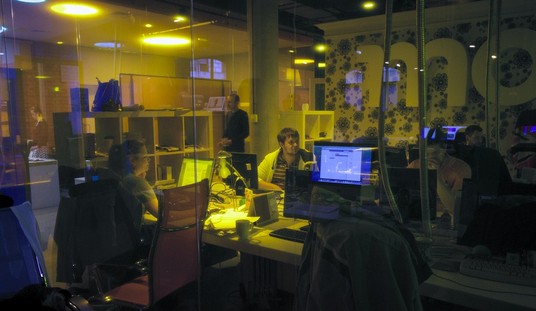Colin Kaepernick, the unemployed quarterback skilled at turning sport into racial politics, should visit the police simulator at the Law Enforcement Legal Defense Fund — if he has the guts to test his assumptions. I had a chance to experience the simulator, and Kaepernick might find that the decisions police officers face aren’t so black and white.
Kaepernick has become a darling of political-sports reporters at outlets like ESPN and the Washington Post. Both have converted their sports brand from providing scores and highlights to now serving up daily heaps of racially charged hostility toward the American justice system.
“If you want a modern example of nakedly racist authoritarianism,” writes Karen Attiah at the Washington Post, “look no further than the National Football League.” Attiah is serious. She is not being sarcastic. The Post pays people to write crazy things.
Attiah should also join Kaepernick at the police simulator, but she probably doesn’t have the guts either.
Cops have become the bad guys. At ESPN and the Washington Post, “hands up, don’t shoot” has never been exposed as the lie we now know it was. America, a nation that sacrificed nearly a million human lives fighting racial injustice in two wars, is, to them, a stew of racial oppression.
To fuel Kaepernick’s victim status at the Washington Post and ESPN, other NFL players are threatening to sit out the season to protest the “injustice” of NFL owners refusing to sign the ex-49’er. Never mind that the owners have come to the correct conclusion that this small and misguided minority is threatening the NFL’s brand by alienating the majority of Americans.
The simulator Kaepernick will probably never see is a lifelike video arcade, where he could play the role of an officer facing stressful, unpredictable simulations. Like an airline simulator or the NASA Apollo simulator, the operator can adjust the sim based on your responses and actions. The sim uses real actors who have filmed multiple potential outcomes. You are armed with a semi-automatic pistol that recoils hard and fires a laser to gauge your hits or misses.
You also have a non-lethal TASER. It’s up to you which to use, depending on the situation.
Some reporters who have tried the simulator think it is always wrong for a police officer to shoot someone in the back.
But sometimes you have to.
In one scenario I tried at the simulator, police dispatch radioed to me that a former employee refused to leave the parking lot where he had just been fired from his job at city hall.
Upon arrival, I found the man’s former supervisor standing next to his truck, imploring him to leave the area. Suddenly, through his pickup’s window, I could see the man put a gun to his own head as the supervisor ran back into city hall.
Police officers can’t just shoot someone threatening to kill himself, can they?
What was a tragic situation became frightening when the man with the gun exited his truck and slowly walked toward his former place of employment.
I shouted for him to drop his gun, but he just kept walking away from me toward the entrance. He kept his gun to his head.
This isn’t so easy, is it? At least most Americans, familiar with the scourge of mass shootings, know a bloodbath may be just beyond that entrance, if he makes it.
But a policeman can’t just shoot someone in the back for walking toward a building with a gun to his head, right?
The trainers at the Law Enforcement Legal Defense Fund provide a crash course in the law to simulator participants before they do the simulations. Some reporters who do the training think it is feasible to simply try to “shoot the gun out of his hand,” or “shoot him in the leg instead.”
Not surprisingly, few of them have shot a firearm at a range before. Even Ginny Thrasher would have a hard time shooting the gun out of the hand of this fellow, back to me, 50 feet away, walking to the entrance of city hall with a gun to his head.
The truth is that police are trained to shoot at large body mass, not index fingers. “Shooting the gun out of someone’s hand” is an urban legend from cheesy 1970s network television.
The first time I did the simulation with the suicidal ex-employee, I was stuck on the idea you can’t shoot a fellow in the back just because he has a gun. So he got into the building and started executing people. I could have stopped it, but was certain it would end my “career” as a cop.
That’s really what the anti-police lobby is all about. Creating a political, ideological and cultural environment where police are afraid to use force. This gang seems more concerned about the bad guys than law abiding Americans.
The second time I did the same gun-to-the-head scenario, I shouted commands to stop and drop the weapon. When these were ignored, I waited until the man was almost inside the building, and I unloaded a clip into his back.
Had I actually done this in Baltimore, street rabble might have burned down another CVS. But police may use deadly force when they reasonably believe that the suspect poses a significant threat of death or injury.
The staff at the simulator also provided hands-on exhibits of so called “non-lethal” force that some are advocating should increasingly replace deadly force. Bean bags, rubber projectiles, and gas all might have a place, but on the margins will jeopardize lives.
The bad guys are even painting orange tips onto their real guns to make police officers freeze up. And sometimes the “toy” gun looks a whole lot like a real gun.
The simulator at the Law Enforcement Legal Defense Fund presents other complicated split-second decisions. It is sufficiently realistic to produce significant stress in the user, the author included. It reveals the real life or death decisions police officers face, decisions that Kaepernick and his champions would benefit from experiening firsthand.
On the other side of this equation is President Trump. The dumbfounded media who cannot understand how he won the White House might also want to visit the simulator. America has always been a nation on the side of the good guys, on the side of law.
I was on the South Lawn last week when Trump gas-lighted the media by noting that NASCAR drivers and crews stand for the national anthem. Kaepernick, the Washington Post, and ESPN so far have failed to persuade America that protesting the national anthem is a noble cause.
All across the country, this week at hockey games, swim meets, and baseball games, Americans will stand and sing the anthem with pride, hand over heart. Kaepernick is against that cultural headwind, and after a day in the police simulator, he looks awfully silly.













Join the conversation as a VIP Member